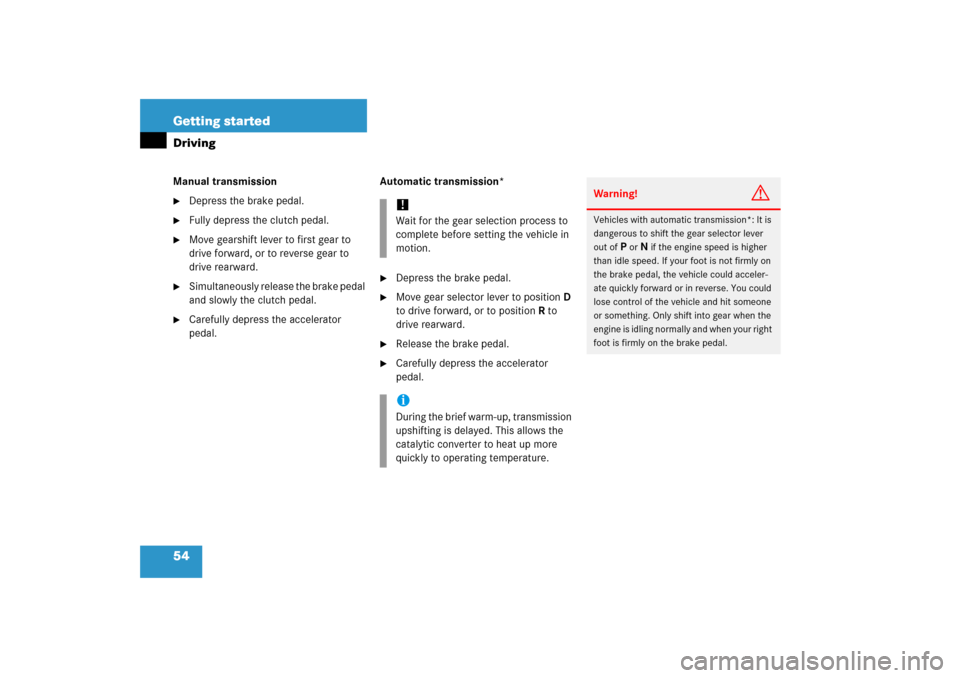Page 55 of 481

54 Getting startedDrivingManual transmission�
Depress the brake pedal.
�
Fully depress the clutch pedal.
�
Move gearshift lever to first gear to
drive forward, or to reverse gear to
drive rearward.
�
Simultaneously release the brake pedal
and slowly the clutch pedal.
�
Carefully depress the accelerator
pedal.Automatic transmission*
�
Depress the brake pedal.
�
Move gear selector lever to positionD
to drive forward, or to positionR to
drive rearward.
�
Release the brake pedal.
�
Carefully depress the accelerator
pedal.!Wait for the gear selection process to
complete before setting the vehicle in
motion.iDuring the brief warm-up, transmission
upshifting is delayed. This allows the
catalytic converter to heat up more
quickly to operating temperature.
Warning!
G
Vehicles with automatic transmission*: It is
dangerous to shift the gear selector lever
out of
PorN if the engine speed is higher
than idle speed. If your foot is not firmly on
the brake pedal, the vehicle could acceler-
ate quickly forward or in reverse. You could
lose control of the vehicle and hit someone
or something. Only shift into gear when the
engine is idling normally and when your right
foot is firmly on the brake pedal.
Page 58 of 481

57 Getting started
Driving
Intermittent wiping
Vehicles with rain sensor*:
Intermittent wiping interval is dependent
on wetness of windshield.�
Turn the combination switch to
positionI.
Vehicles with rain sensor*:
After the initial wipe, pauses between
wipes are automatically controlled by
the rain sensor.Single wipe
�
Press the combination switch briefly in
direction of arrow1 to the resistance
point.
The windshield wipers wipe one time
without washer fluid.
Wiping with windshield washer fluid
�
Press the combination switch in direc-
tion of arrow1 past the resistance
point.
The windshield wipers operate with
washer fluid.
For information on filling up the washer
reservoir, see “Windshield washer system
and headlamp cleaning system*”
(
�page 315).
!Vehicles with rain sensor*:
Do not leave windshield wipers in inter-
mittent setting when vehicle is taken to
an automatic car wash or during wind-
shield cleaning. Windshield wipers will
operate in the presence of water
sprayed on the windshield, and wind-
shield wipers may be damaged as a
result.
iIntermittent wiping is interrupted when
the vehicle is at a standstill and a door
is opened. This helps to avoid people
being sprayed with water from wiper
action when getting into and out of the
vehicle.
Intermittent wiping will be continued
when�
all doors are closed
and
�
the clutch pedal is depressed (vehi-
cles with manual transmission)
or
�
the gear selector lever is in
positionDorR (vehicles with auto-
matic transmission*)
or
�
the wiper setting is changed using
the combination switch
iTo prevent smears on the windshield,
wipe with windshield washer fluid every
now and then even when it is raining.
Page 60 of 481

59 Getting started
Parking and locking
�Parking and locking
You have now completed your first drive.
You have properly stopped and parked
your vehicle. End your drive as follows.
Parking brake
1Parking brake lever
2Release button�
Pull up parking brake lever1 firmly.
When the ignition is switched on or the
engine is running, the brake warning
lamp; (USA only) or3 (Canada
only) in the speedometer dial comes
on.
Warning!
G
Vehicles with manual transmission:
Wait until the vehicle is stationary before re-
moving the SmartKey from the starter
switch. The vehicle cannot be steered when
the SmartKey is removed.Warning!
G
With the engine not running, there is no
power assistance for the brake and steering
system. In this case, it is important to keep
in mind that a considerably higher degree of
effort is necessary to brake and steer the ve-
hicle.
Warning!
G
Do not park this vehicle in areas where com-
bustible materials such as grass, hay or
leaves can come into contact with the hot
exhaust system, as these materials could be
ignited and cause a vehicle fire.
To reduce the risk of personal injury as a re-
sult of vehicle movement, before turning off
the engine and leaving the vehicle always:�
Keep right foot on brake pedal.
�
Pull up the parking brake lever firmly.
�
Move the gear selector lever* to
position
P (manual transmission: first or
reverse gear).
�
Slowly release brake pedal.
�
When parked on an incline, turn front
wheels towards the road curb.
�
Turn the SmartKey in the starter switch
to position
0 and remove the SmartKey
from the starter switch.
�
Take the SmartKey and lock vehicle
when leaving.
Page 61 of 481

60 Getting startedParking and locking
Switching off headlamps�
Turn exterior lamp switch toM
(�page 55).
For more information, see “Lighting”
(
�page 110).
Warning!
G
Getting out of your vehicle with the gear se-
lector lever* not fully engaged in positionP
(manual transmission: first or reverse gear)
is dangerous. Also, when parked on an in-
cline, positionP (manual transmission: first
or reverse gear) alone may not prevent your
vehicle from moving, possibly hitting people
or objects.
Always set the parking brake in addition to
shifting to positionP (manual transmission:
first or reverse gear).
When parked on an incline, turn the front
wheels towards the road curb.
Warning!
G
When leaving the vehicle, always remove the
SmartKey from the starter switch, take it
with you, and lock the vehicle. Do not leave
children unattended in the vehicle, or with
access to an unlocked vehicle. Children
could release the parking brake and/or
move the gear selector lever* from
positionP (manual transmission: into
Neutral), either of which could result in an
accident and/or serious injury.
Page 62 of 481

61 Getting started
Parking and locking
Turning off engine �
Manual transmission: Move the gear-
shift lever into first or reverse gear.
�
Automatic transmission*: Place the
gear selector lever in positionP.
�
Turn the SmartKey in the starter switch
to position0 and remove the SmartKey
from the starter switch.
The immobilizer is activated.
�
Press the seat belt release button
(�page 49).
�
Guide the latch plate to allow the re-
tractor to completely rewind the seat
belt.
iAlways set the parking brake in addi-
tion to shifting into first or reverse gear
(automatic transmission*: gear selec-
tor lever in positionP).
On slopes, turn the front wheels to-
wards the road curb.
iVehicles with automatic transmission*:
The SmartKey can only be removed
from the starter switch with the gear
selector lever in positionP.
!Make sure the seat belt retracts fully so
that the seat belt and/or latch plate
cannot get caught or pinched in the
door or in the seat mechanism. This
can damage the seat belt and impair
the effectiveness of the seat belt,
and/or cause damage to the door
and/or door trim panel. Such damage
is not covered by the Mercedes-Benz
Limited Warranty.
Damaged seat belts must be replaced.
Contact an authorized Mercedes-Benz
Center.iWith the SmartKey removed from the
starter switch and the driver’s door
open, a warning sounds if the parking
lamps or low beam headlamps are
switched on (
�page 110).
The message Turn off lights
appears
in the multifunction display.
Page 92 of 481
91 Controls in detail
Locking and unlocking
Seats
Memory function*
Lighting
Instrument cluster
Control system
Manual transmission
Automatic transmission*
Good visibility
Climate control
Automatic climate control*
Audio system
Power windows
Retractable hardtop
Driving systems
Useful features
Page 113 of 481

112 Controls in detailLightingDaytime running lamp mode�
Turn exterior lamp switch to
positionMorU.
When the engine is running, the low
beam headlamps are switched on.
In low ambient light conditions, the fol-
lowing lamps will switch on additional-
ly:�
Tail and parking lamps
�
License plate lamps
�
Side marker lamps
For nighttime driving you should turn the
exterior lamp switch to positionB to
permit activation of the high beam head-
lamps.Canada only:
The daytime running lamp mode is manda-
tory and therefore in a constant mode.
Vehicles with automatic transmission*:
When the engine is running, and you shift
from a driving position to positionN orP,
the low beam headlamps will switch off
with a three-minute delay.
When the engine is running, and you
�
turn the exterior lamp switch to
positionC, the parking lamps
switch on additionally.
�
turn the exterior lamp switch to
positionB, the manual headlamp
mode has priority over the daytime run-
ning lamp mode.
The corresponding exterior lamps
switch on (
�page 110).USA only:
By default, the daytime running lamp mode
is deactivated. Activate the daytime run-
ning lamp mode using the control system,
see “Setting daytime running lamp mode”
(
�page 143).
When the engine is running, and you turn
the exterior lamp switch to
positionCorB, the manual head-
lamp mode has priority over the daytime
running lamp mode.
The corresponding exterior lamps switch
on (�page 110).
iWith the daytime running lamp mode
and the exterior lamp switch in
positionM you cannot switch on the
high beam headlamps.
The high beam flasher is available at all
times.
Page 124 of 481

123 Controls in detail
Control system
�Control system
The control system is activated as soon as
the SmartKey in the starter switch is
turned to position1. The control system
enables you to�
call up information about your vehicle
�
change vehicle settings
For example, you can use the control sys-
tem to find out when your vehicle is next
due for service, to set the language for
messages in the instrument cluster dis-
play, and much more.
The control system relays information to
the multifunction display.
Multifunction display
1Main odometer
2Trip odometer
3Current program mode
(automatic transmission* only)
4Status indicator (outside tempera-
ture/digital speedometer)
5Current gear selector lever posi-
tion/gear range
(automatic transmission* only)
iThe displays for the audio systems
(radio, CD player) will appear in English,
regardless of the language selected.
Warning!
G
A driver’s attention to the road and traffic
conditions must always be his/her primary
focus when driving.
For your safety and the safety of others, se-
lecting features through the multifunction
steering wheel should only be done by the
driver when traffic and road conditions per-
mit it to be done safely.
Bear in mind that at a speed of just 30 mph
(approximately 50 km/h), your vehicle is
covering a distance of 44 feet (approximate-
ly 14 m) every second.